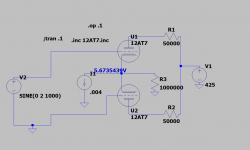Help a new tube-amp builder.
In the Mullard 5-10 topology if I do not need the gain of the first stage can I apply the input signal directly to the longtail splitter? I am thinking 12AT7 splitter with CCS.
Or is the first stage needed to apply NFB?
(Be kind if this a stupid question)
In the Mullard 5-10 topology if I do not need the gain of the first stage can I apply the input signal directly to the longtail splitter? I am thinking 12AT7 splitter with CCS.
Or is the first stage needed to apply NFB?
(Be kind if this a stupid question)
If you are building an amp like the 5-10 (EL84's) you could use 1/2 of a 12AT7 for gain and the other 1/2 for a cathodyne phase splitter. This is what's done in the Tubelab.com SPP amp.
The Valve Wizard
The Valve Wizard
Feedback can always be applied to the normally AC grounded side of an LTP. You don’t necessarily need another stage just to be able to apply feedback. LTPs do subtraction, too. DC conditions won’t be the same as with the normal input stage, but you can design around that. Using a CCS and even a small negative rail makes it easy. If the feedback is the wrong phase, swap the OPT transformer phase to provide the necessary reversal. Open loop gain will be a lot lower, on the order of what a single ended pentode with 12A*7 driver would be.
In relation to the question "can I use a CCS instead" .
A CCS in this situation does not deliver equal output signal amplitudes , plate resistances would need to be different - left slightly lower value , I would look at the options suggested above.
You get a lot closer to balance with a CCS than you do with a tail resistor. Make the balance adjustable if it’s not intrinsically good enough.
In relation to the question "can I use a CCS instead" .
A CCS in this situation does not deliver equal output signal amplitudes , plate resistances would need to be different - left slightly lower value , I would look at the options suggested above.
Maybe going down a rathole but I can't see how how the input stage in the original 5-10 schematic effects the splitter to deliver equal output amplitudes. All I can see its there for is to provide gain and a convenient place to apply NFB. Right?
Never read of impedance matching in a tube amp and under what circumstances each stage in an amp functions best? Read some of the basic tube educational literature, its free available on the net.
Have you've ever seen an amp that starts in topology with a phase splitter stage?
Have you've ever seen an amp that starts in topology with a phase splitter stage?
can I apply the input signal directly to the longtail splitter?
Sure you can. You just need to properly design the LTS for proper bias and operation.
Never read of impedance matching in a tube amp and under what circumstances each stage in an amp functions best? Read some of the basic tube educational literature, its free available on the net.
Have you've ever seen an amp that starts in topology with a phase splitter stage?
Impedance match to what exactly? I will feed this with a Ram RM-5 preamp that has a 6DJ8 output stage. Isn't that essentially a practical driver for the splitter? I suppose that for a commerical product where you don't know how the amp will be fed an input driver probably the best way to it. If I didn't need gain though, I'd go with a cathode follower then. Right?
I am not arguing against a driver but just asking exactly what the function is. The only responses so far other than hand waving is that is a convenient way to apply NFB.
Last edited:
No, its not. What defines the output stage of your source. The type of tube you use or the type of circuit it uses? I would say your using a cathode follower stage at the output.
Does this match quite good with a phase splitter input?
You have to think in block schematics and to study what each block has input and output impedances, loadlines and headroom for signal amplifying. Then you will reach the goal.
Does this match quite good with a phase splitter input?
You have to think in block schematics and to study what each block has input and output impedances, loadlines and headroom for signal amplifying. Then you will reach the goal.
- Status
- This old topic is closed. If you want to reopen this topic, contact a moderator using the "Report Post" button.
- Home
- Amplifiers
- Tubes / Valves
- Mullard 5-10 input stage needed?
